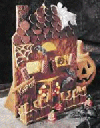|
Gingerbread
|

|
|
|
|
Halloween History & Traditions
The History of Halloween
Bats are part of modern Halloween folklore, but do not figure into most old tales.
Ever wonder how Halloween came to be such a fun day for kids and adults alike? We trace the history of this holiday from its rather serious beginnings 2000 years ago to today's celebration of tricks and treats.
Although trick-or-treating itself can be traced to Irish immigrants who brought the idea to the United States in the 1800s, other customs of Halloween date back much further.
The Irish celebration of Halloween (Hallow "E'en" for "evening") comes from a religious feast -- All Hallows Day, better known today as All Saints Day. Since the ninth century, Christians have celebrated All Hallows Day on November 1 in honor of deceased holy persons, or saints, referred to as "Hallows."
The Christian Halloween adopted traditions from a much older Celtic holiday. More than 2000 years ago, the Druids observed a festival called Samhain, during which the god of the dead, they believed, came back to earth accompanied by ghosts and goblins. Sound familiar? The Celtic people wore animal skins and animal heads to hide from these evil spirits, and Druid priests burned sacrifices to appease the spirits.
Today's popular Halloween colors recall the orange bonfires against the black nighttime skies. Costuming expanded from animals and spooky creatures to saints and, as we see today, to personalities in the popular culture.
Halloween History & Traditions
Halloween Traditions
Check out the background and history of some of today's more popular Halloween traditions, as well as some that may surprise you.
Trick-or-treating. Where did we get the tradition of dressing in costumes to ask for goodies? Beggars in Ireland began the tradition centuries ago when they made the rounds to visit the rich and ask for money (and threaten them with evil spirits if they didn't give!). In some neighborhoods, trick-or-treaters must recite a riddle to get a treat.
Jack-o'-lanterns. Like Halloween, the tradition of carving pumpkins comes from the Celts. According to legend, a miserly man named Jack was doomed to wander the earth after he died. He carried a lantern carved out of a turnip. He was "Jack-o'-lantern." On All Hallows Eve, the Irish and Scots carried similar lanterns.
Witches on broomsticks and black cats. In the Middle Ages, it was believed that witches were especially dangerous, because on Halloween night they could fly to meet with the devil. Some people believed their pet black cats were witches transformed or even the dead come back to life.
Halloween and a sneeze. Why do people say "God bless you" when you sneeze? The Welsh believed that a sneeze blew the soul right out of the body. If someone sneezed on Halloween, people would bless one another to keep the devil from capturing the soul.
In addition to the Druid influence, Roman harvest festivals of the first century A.D., especially one honoring Pomona, the goddess of fruit, also put their stamp on the celebration.
Bobbing for apples is recorded in medieval manuscripts. Today's popular Halloween imagery of pumpkins and cornfield mazes reflects the Roman tradition of celebrating a good harvest.
The most common tradition in today's Halloween, trick-or-treating, is a reenactment of Irish beggars going to the homes of the rich on All Hallows Eve to ask for food or money. If the rich refused, evil spirits -- so the beggars said -- would destroy their homes.
Trick-or-treating became widespread in America in the 1940s. Costumed children went house-to-house asking for small handouts, usually candy. In return, no tricks would be played.
In today's times, families focus on safety, trick-or-treating only at the homes of people they know. Many communities put the emphasis on costume parades, school parties, and controlled "haunted" houses.
 "Always Kiss The Cook" "Always Kiss The Cook"
|


